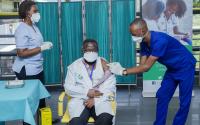Long-haul COVID-19 likelihood associated with middle age, female sex
Researchers reporting on two non-peer–reviewed studies published this week on the preprint server medRxiv followed up months after adults’ COVID-19 hospitalization and found that 55% to 71% have not fully recovered. Middle age and female sex were associated with a higher likelihood of worse recovery in both studies.
The larger study involved 1,077 UK patients (median age, 58) a median of 5 months after hospital discharge. While 28.8% felt fully recovered, 19.6% had a new disability, 17.8% of those who were working in full- or part-time capacity no longer were, and 19.3% had undergone a health-related change in occupation. Additionally, 1 in 4 had clinically significant symptoms of anxiety and depression, 12.2% had post-traumatic stress disorder, 17% had mild cognitive impairment, and 46% had lower physical performance.
Factors associated with worse recovery included female sex, White ethnicity, and having two or more comorbidities. The researchers noted that age had a nonlinear association: Compared with those 50 to 59, those younger than 30 or older than 70 were 2.28 times and at least 2.07 times more likely to recover, respectively.
“The magnitude of the ongoing mental and physical health burden was substantial, but perhaps surprisingly were largely unrelated to acute severity,” the researchers write.
Mar 24 medRxiv study
The other study looked at 327 hospitalized UK COVID-19 patients (median age, 59.7). Most were not fully recovered after a median of 222 days (7.4 months), and women under 50 were the most burdened. Compared with men of the same age, women were 5.09 times less likely to feel recovered, 4.22 times more likely to report a greater disability, 2.06 times as likely to have worse fatigue, and 7.15 times more likely to experience breathlessness.
Breathlessness was not associated with age or comorbidities, fatigue intensity was not associated with age or disease severity, and new or worsened disability (such as mobility and memory) was not associated with comorbidities or disease severity.
“These symptoms were largely independent of age and prior comorbidity, suggesting that the long-term effects of Covid-19 are determined by factors that differ from those that predict increased mortality,” write the researchers.
Mar 23 medRxiv study
Table of Contents
Hospital PPE supplies had mostly rebounded by fall, but reuse common
Although 86.6% of survey respondents believed their healthcare facility had adequate personal protective equipment (PPE) for its staff last fall, only 74.5% of respondents believed their facility’s PPE reuse protocols were safe, and 70.8% believed they were based on evidence, according to results published yesterday in the American Journal of Infection Control.
From Oct 22 to Nov 9, 2020, the Association for Professionals in Infection Control and Epidemiology surveyed 1,081 US infection preventionists (IPs). One in four respondents said they lacked enough disinfection supplies, N95 respirators, isolation gowns, and gloves, and 10% to 20% said they didn’t have sufficient eye protection and hand hygiene supplies.
Early in the pandemic, reports flooded social and mainstream media about widespread PPE shortages as COVID-19 cases inundated US hospitals.
Reuse had become commonplace for respirators (65.6%, with 38.6% of those reusing as much as possible), masks (46.8%, with 56.7% of those reusing as much as possible), and isolation gowns (32.0%). Almost half (45.9%) were decontaminating respirators, with the most common methods being vaporized hydrogen peroxide (24.1%) and ultraviolet germicidal irradiation (19.0%).
IPs were more likely to believe their facility’s PPE reuse protocols were safe and evidence-based if the IP was involved in COVID-19 protocol development, if the facility had reusable respiratory protection, if respirators were decontaminated, if masks were not reused, and if respirators were reused five times or fewer.
PPE supplies were not consistent across facilities, according to the survey. For instance, critical-access hospitals and ambulatory care facilities were less likely to have sufficient masks or adequate gloves.
“Ongoing gaps in PPE access need to be addressed in order to minimize healthcare associated infections and occupational illness,” the researchers write. “Although most US healthcare facilities reported having adequate PPE, hand hygiene products, and disinfection supplies in fall, 2020, this was due to the high frequency of PPE crisis standards being implemented.”
Mar 25 Am J Infect Control study
North Carolina H1N1v flu infection linked to swine exposure
The Centers for Disease Control and Prevention (CDC) today reported a variant H1N1 (H1N1v) case, which involves a North Carolina resident who had daily contact with pigs.
In its weekly FluView report, the CDC said the patient’s sample was collected in 2020, but H1N1v wasn’t identified until 2021. Thus, the case marks the nation’s first case for 2020.
An investigation found no instances of human-to-human transmission related to the case. The US reported its last H1N1v case in 2019, which involved a patient from Michigan who had no contact with swine. The CDC said swine flu viruses, including H1N1, sporadically infect people, causing symptoms that are similar to seasonal flu.
Mar 26 CDC FluView report
South Sudan, Tajikistan report more vaccine-derived polio cases
Two countries—South Sudan and Tajikistan—reported new polio cases this week, both involving circulating vaccine-derived poliovirus type 2 (cVDPV2), according to the latest weekly update from the Global Polio Eradication Initiative (GPEI).
South Sudan reported 3 cases in different states: Unity, Jonglei, and Equatoria, raising the country’s total to 54, which includes 4 reported in 2021.
Tajikistan reported two more cases, both in Khatlon province, lifting its total for 2021 to five.
Mar 25 GPEI update
GPEI circulating vaccine-derived polio page












